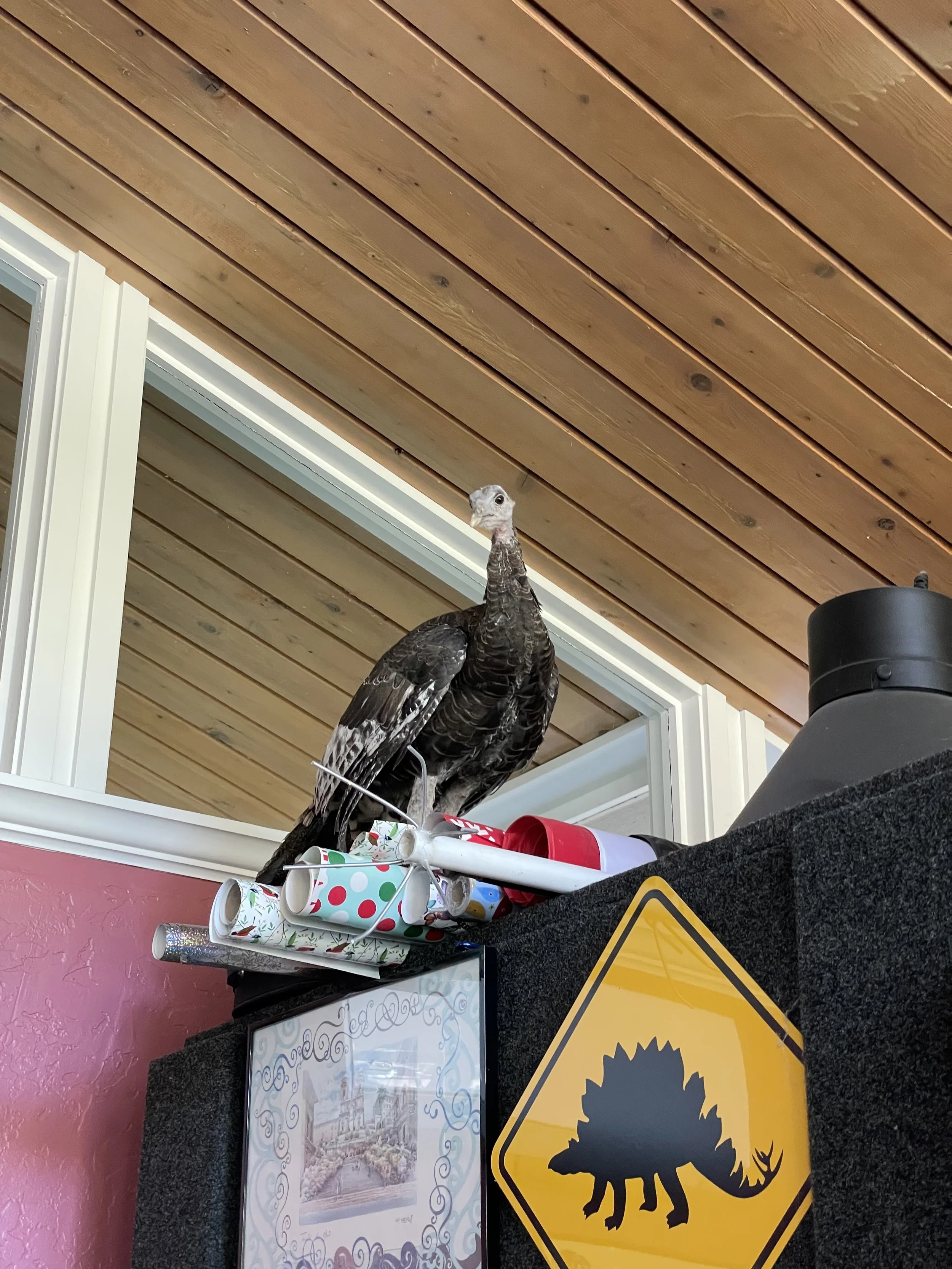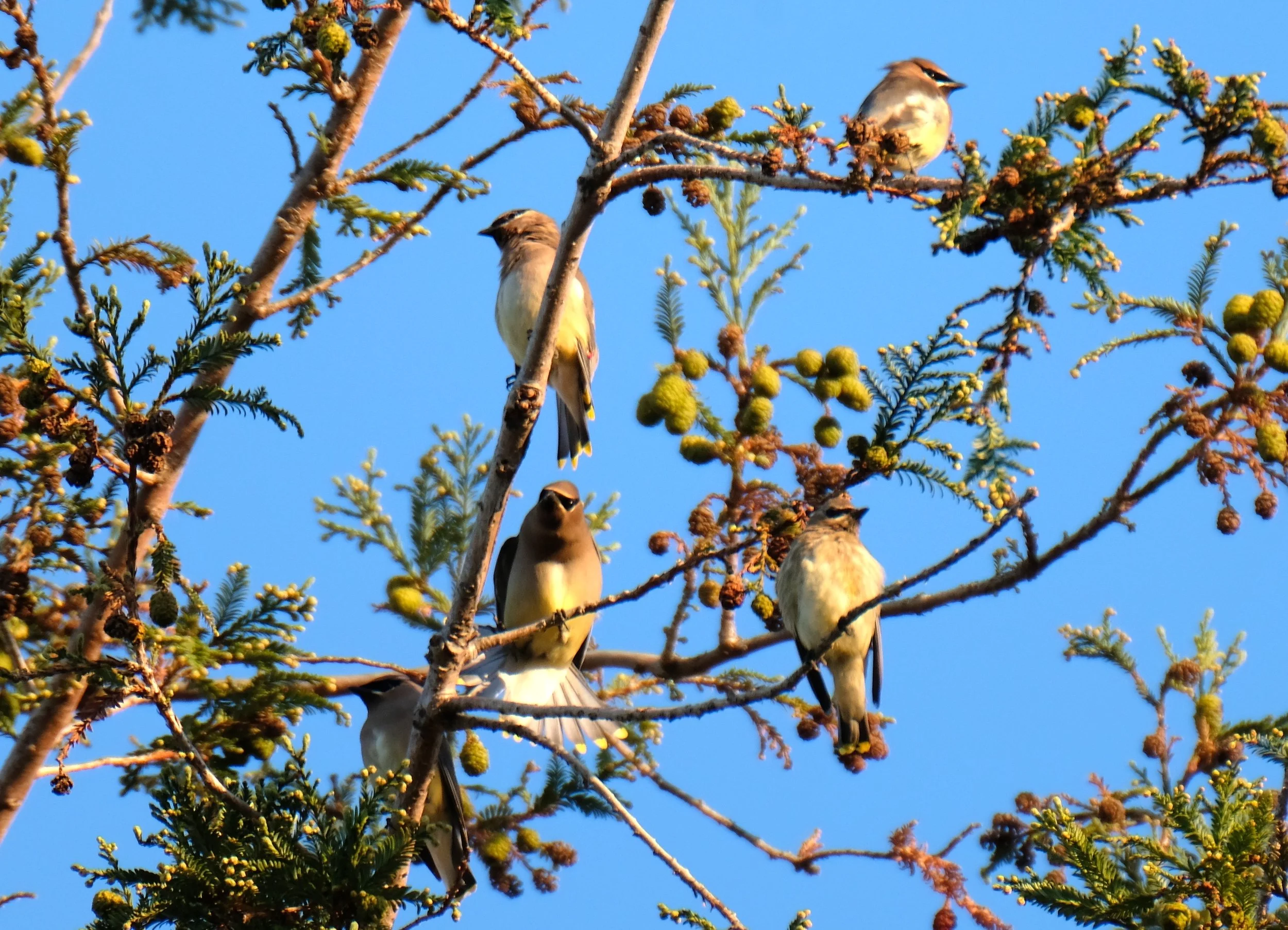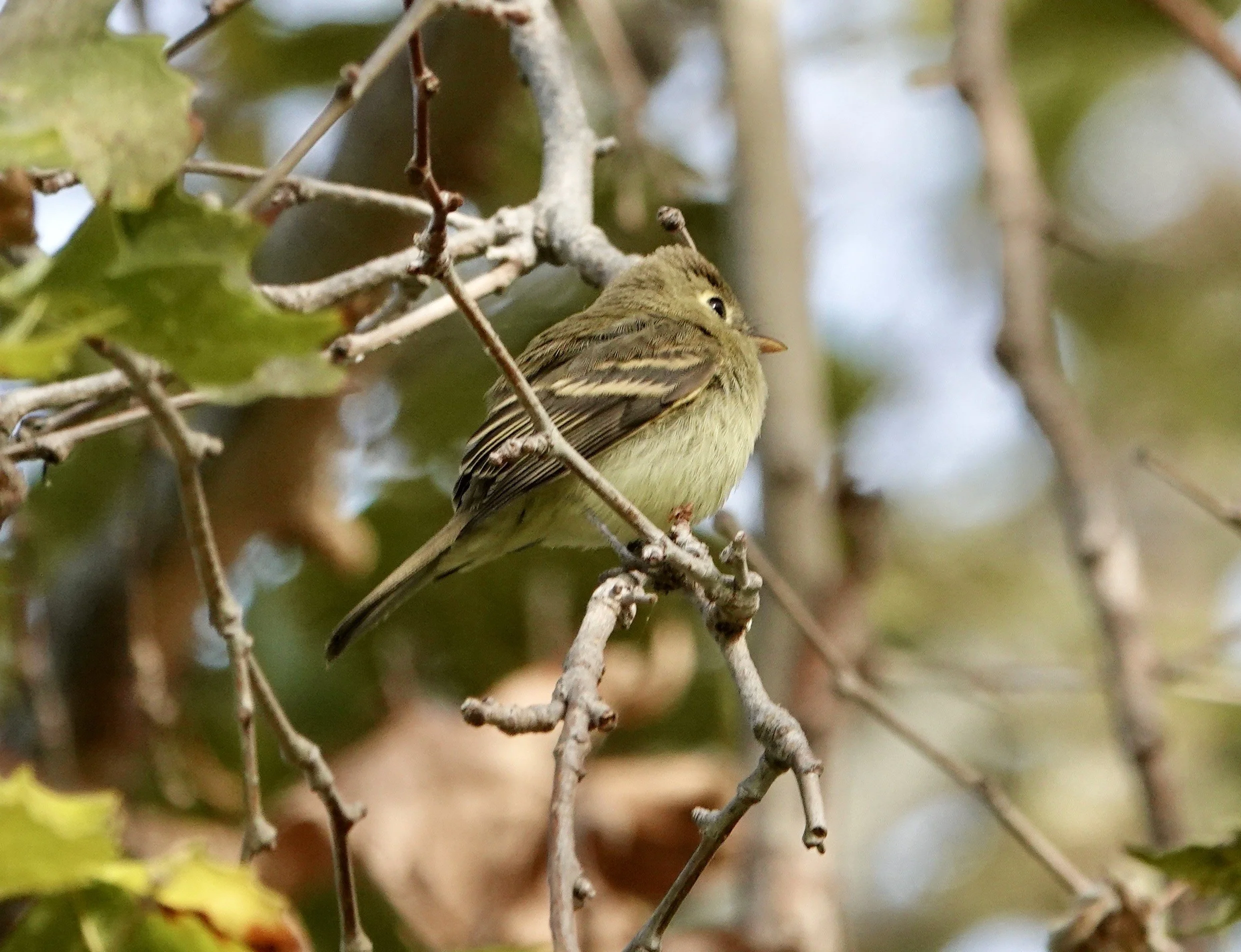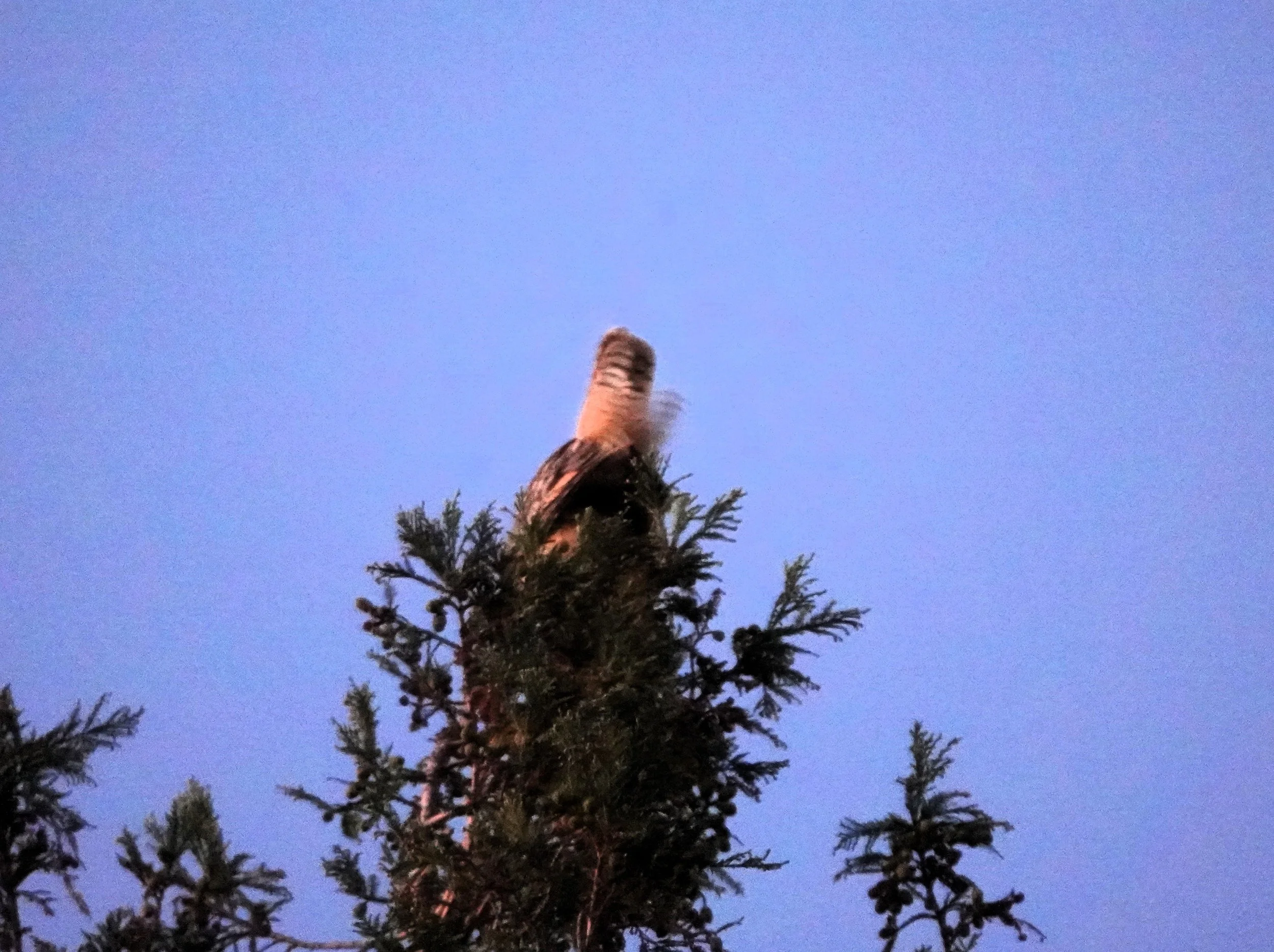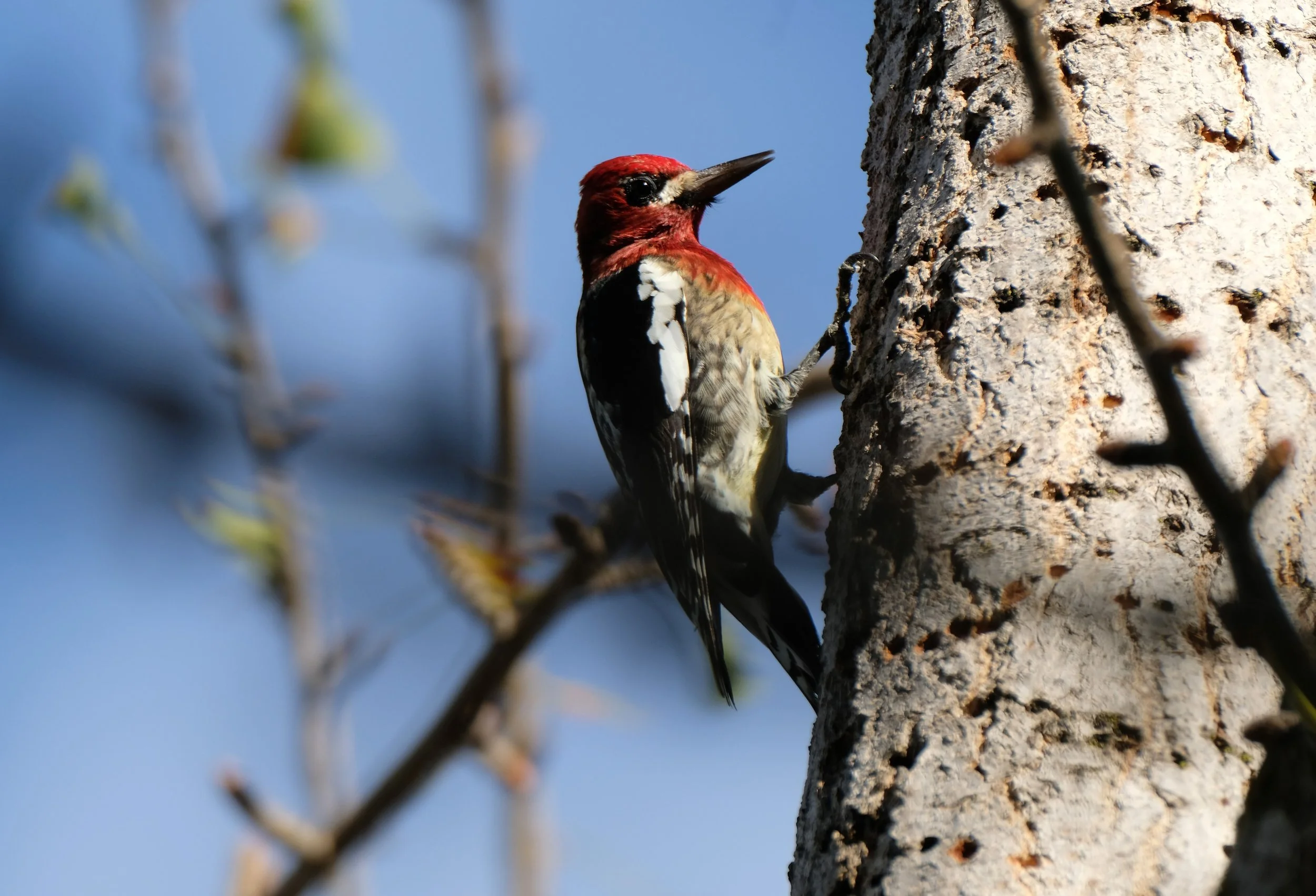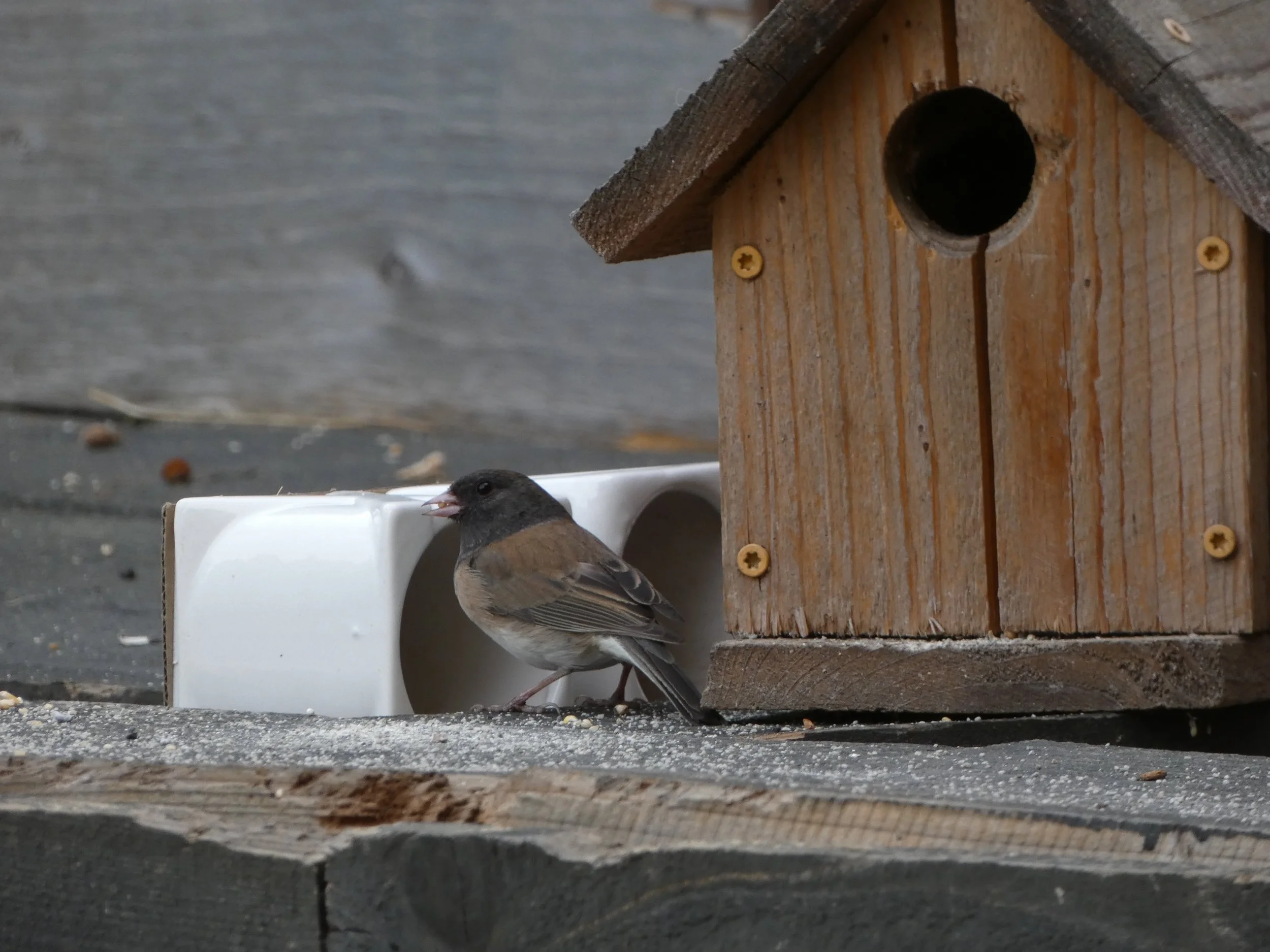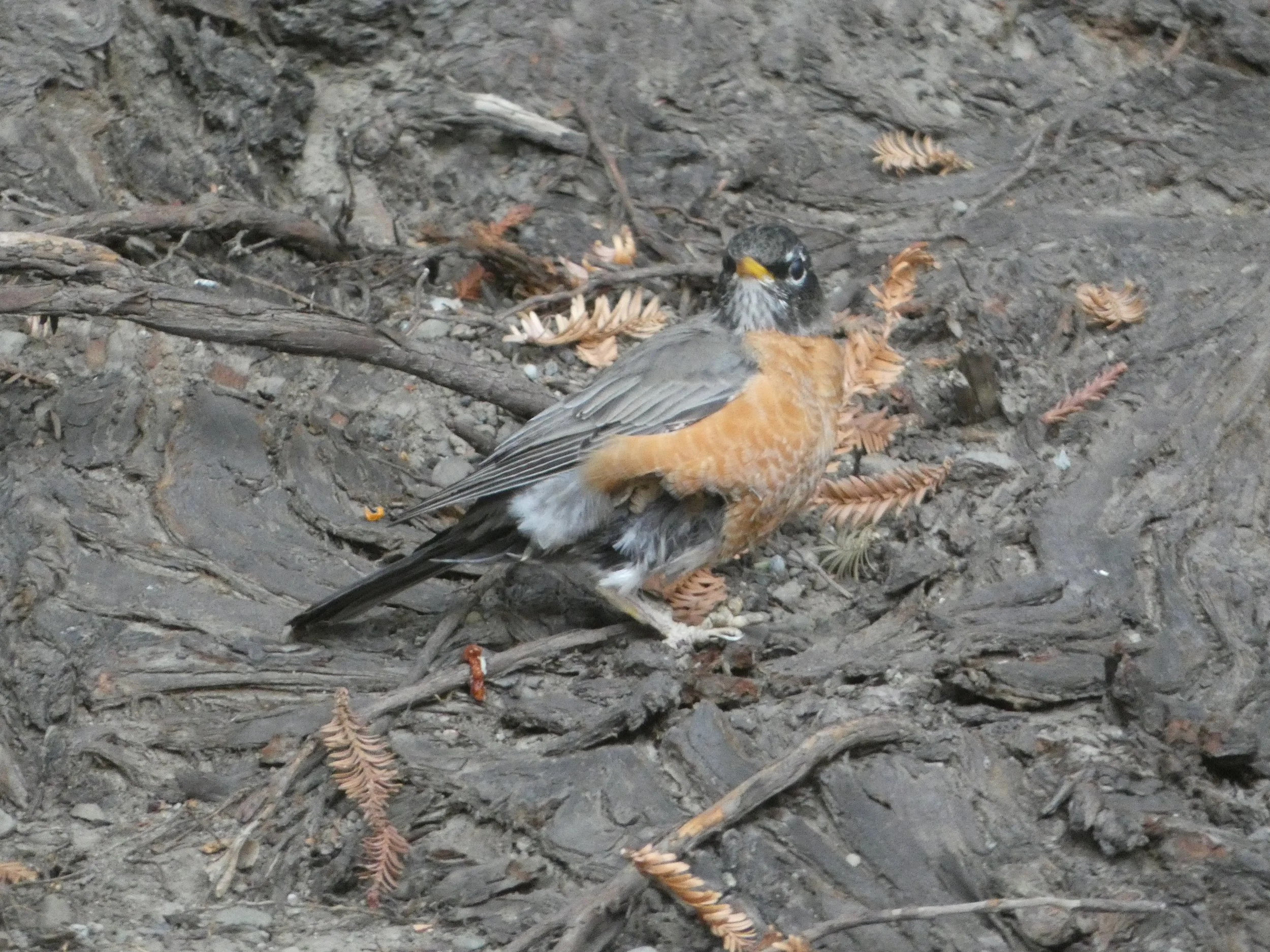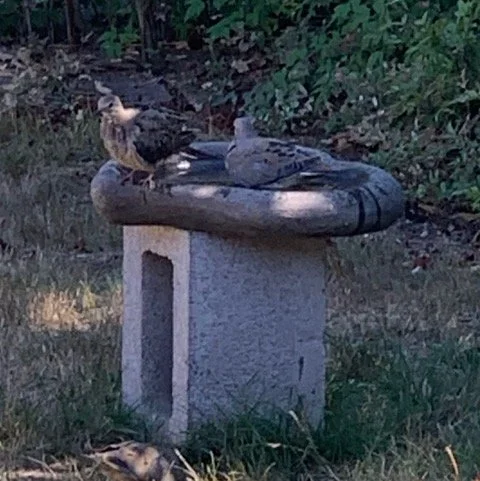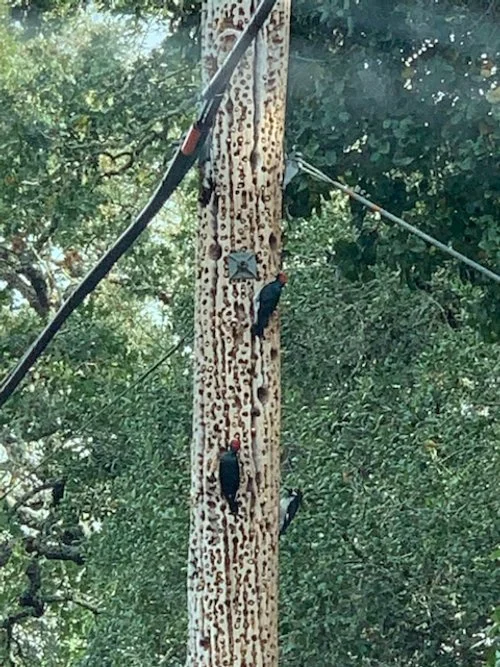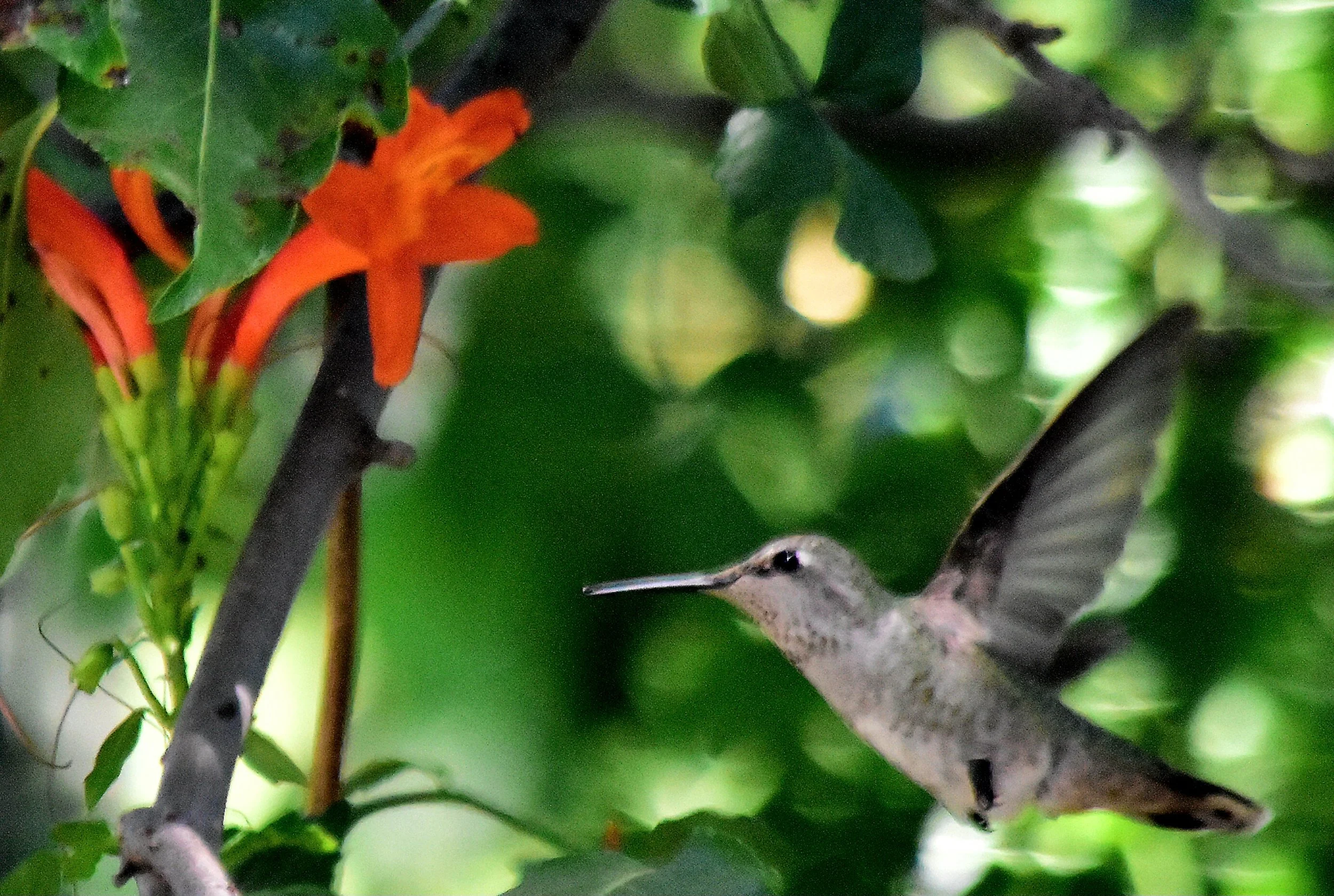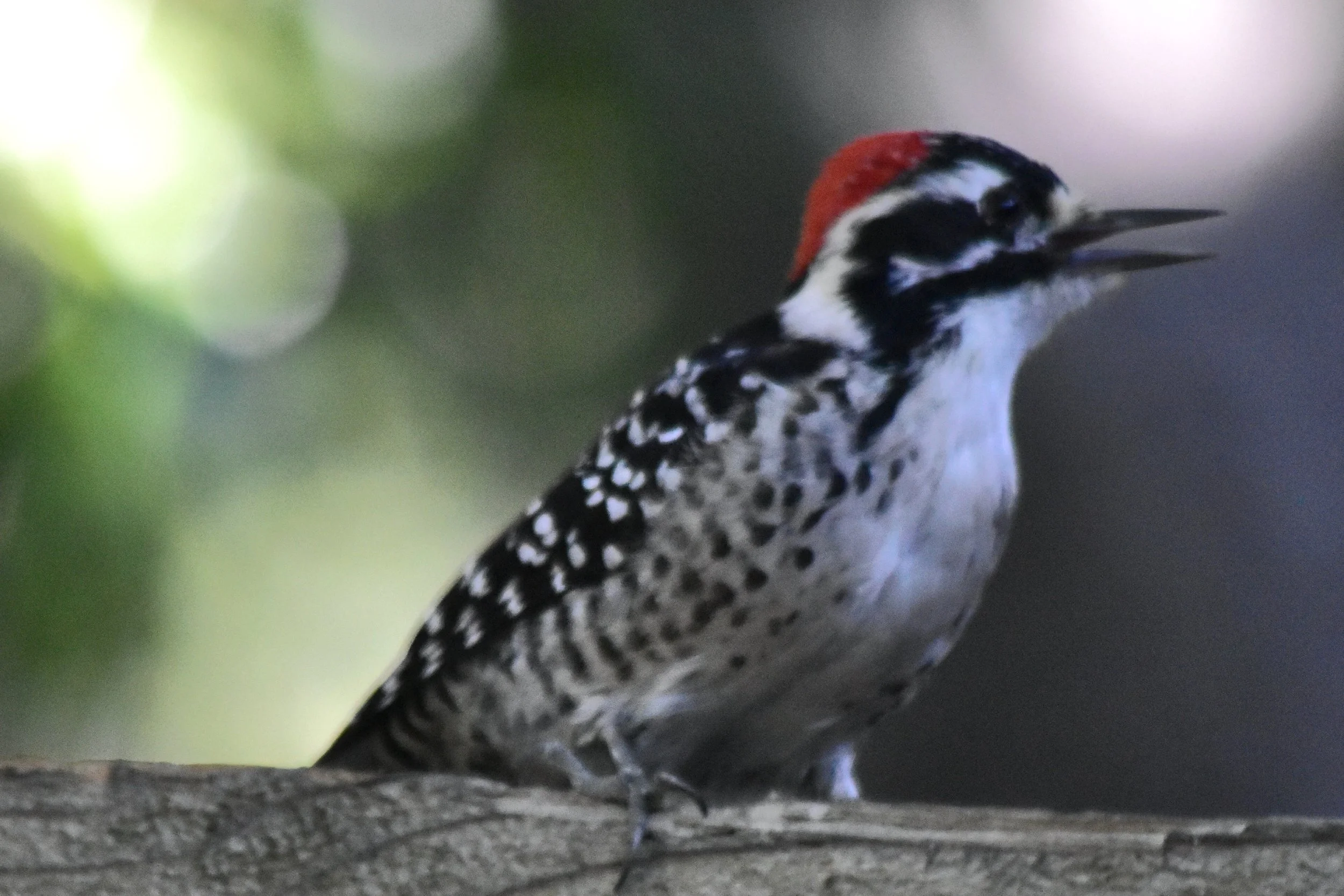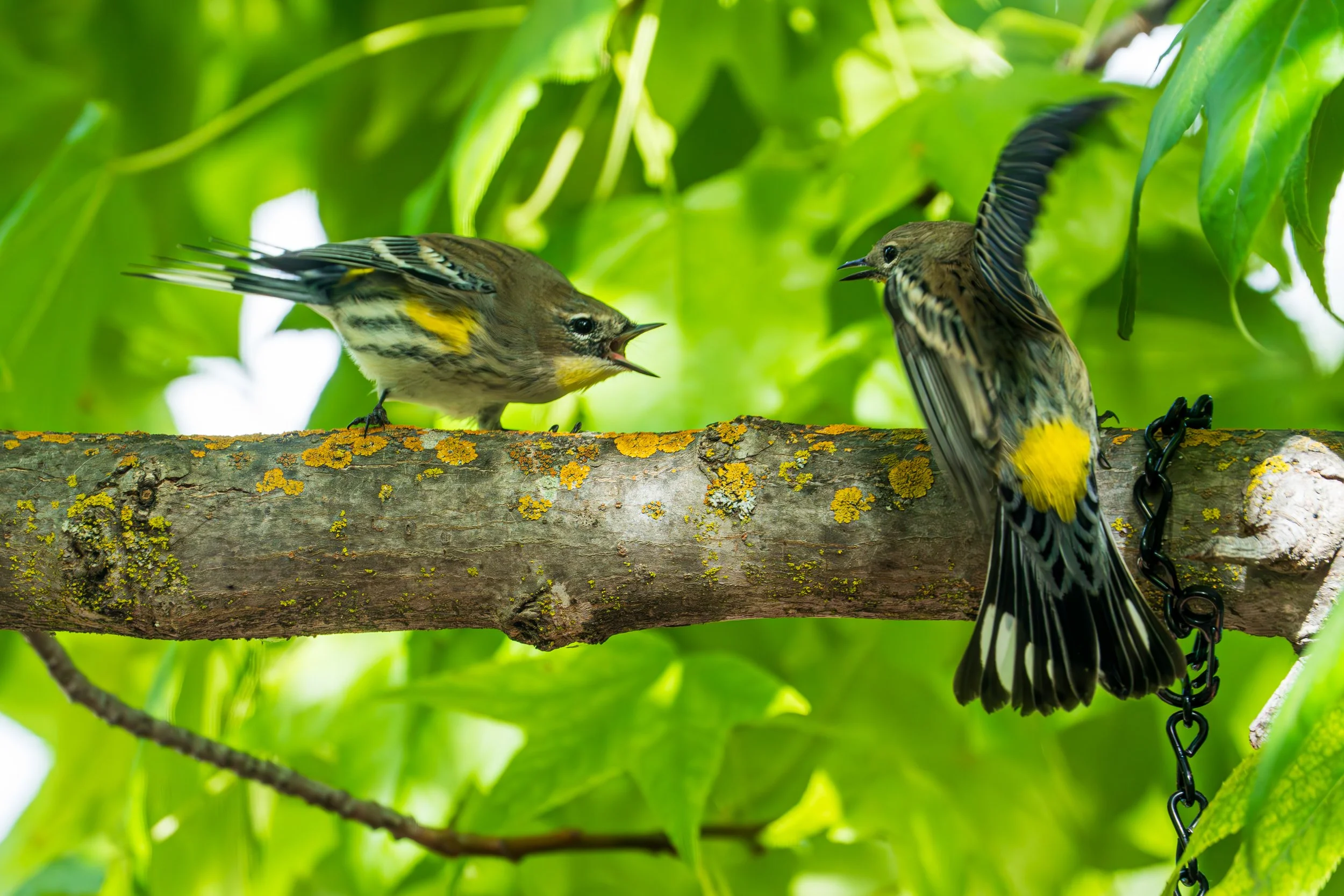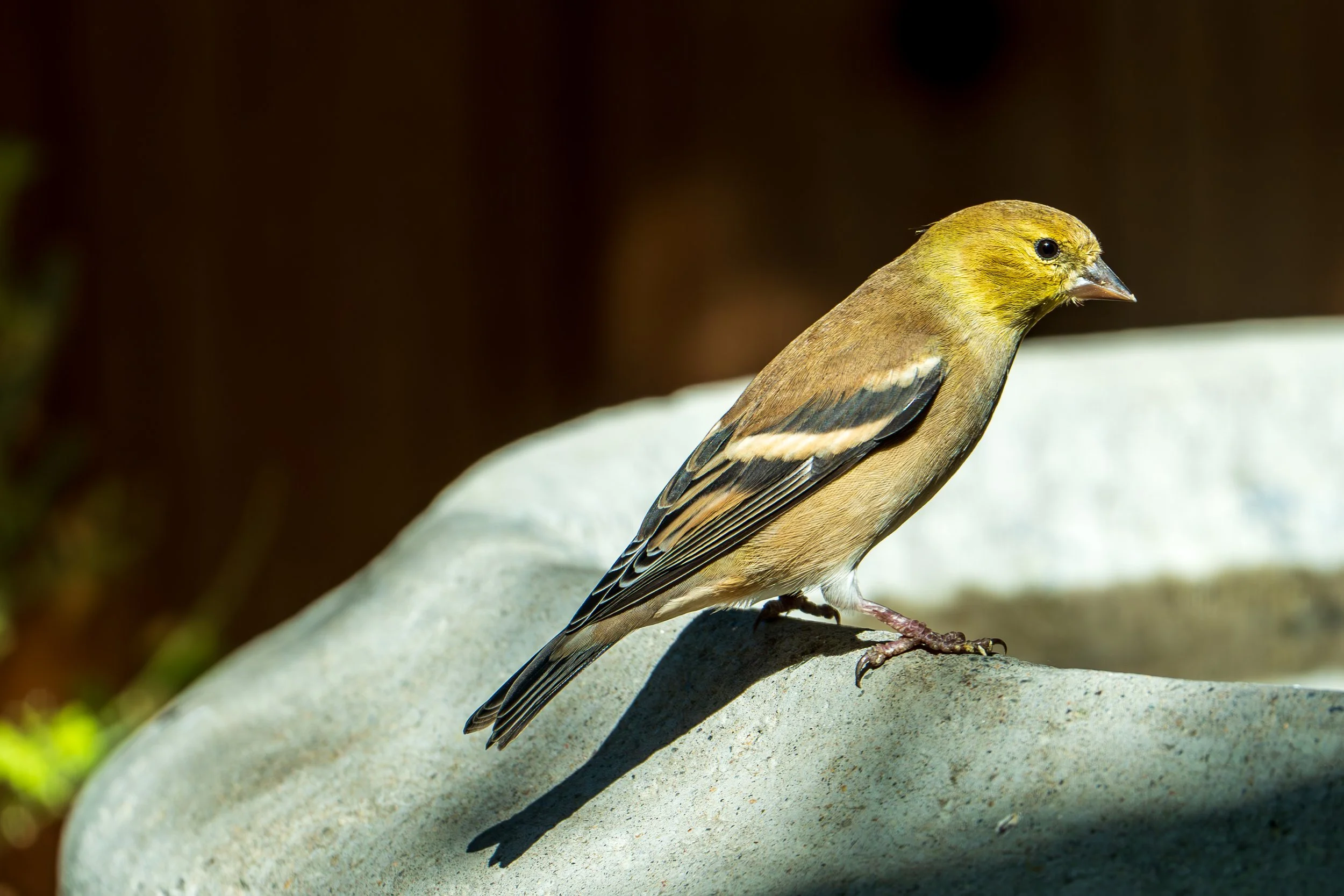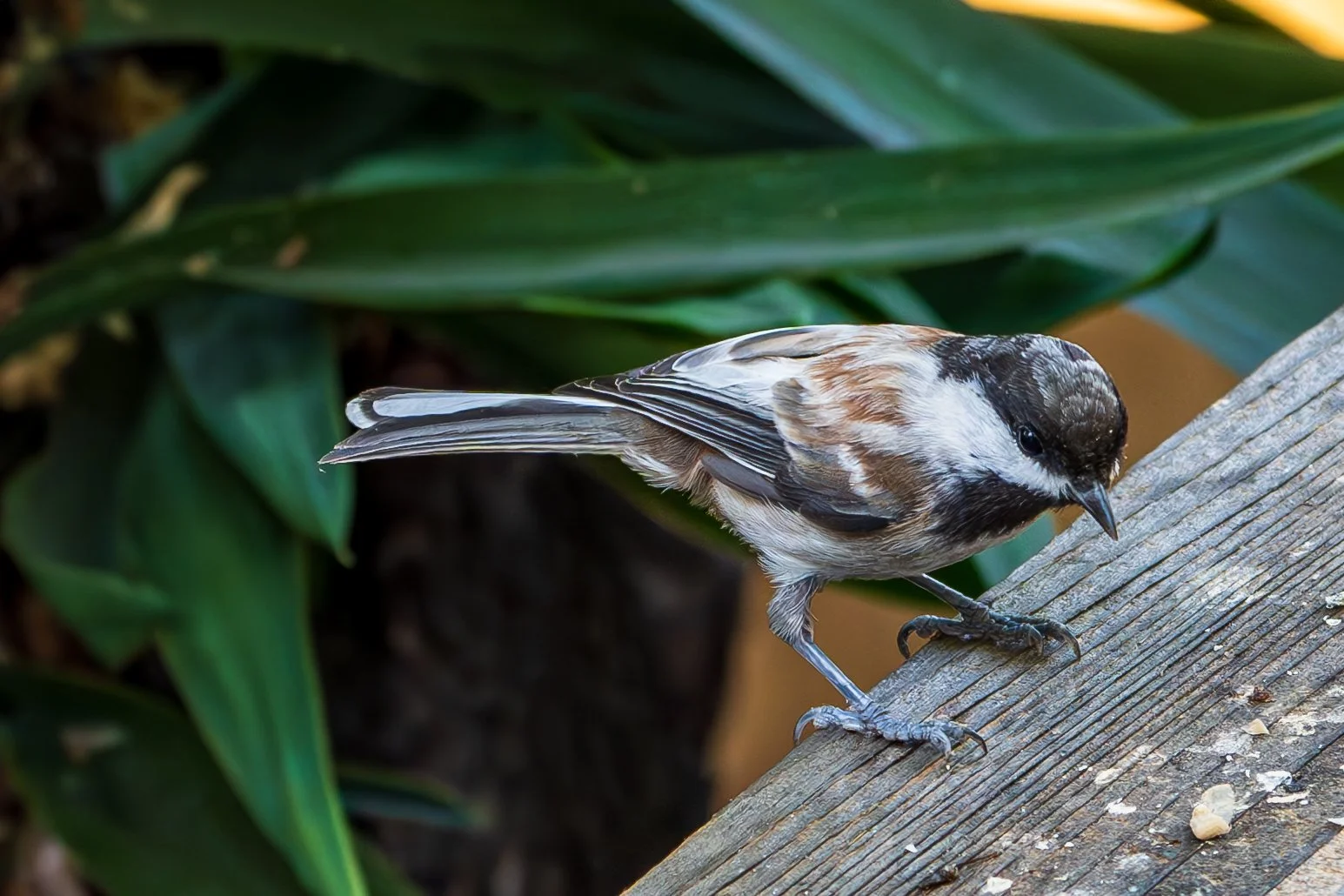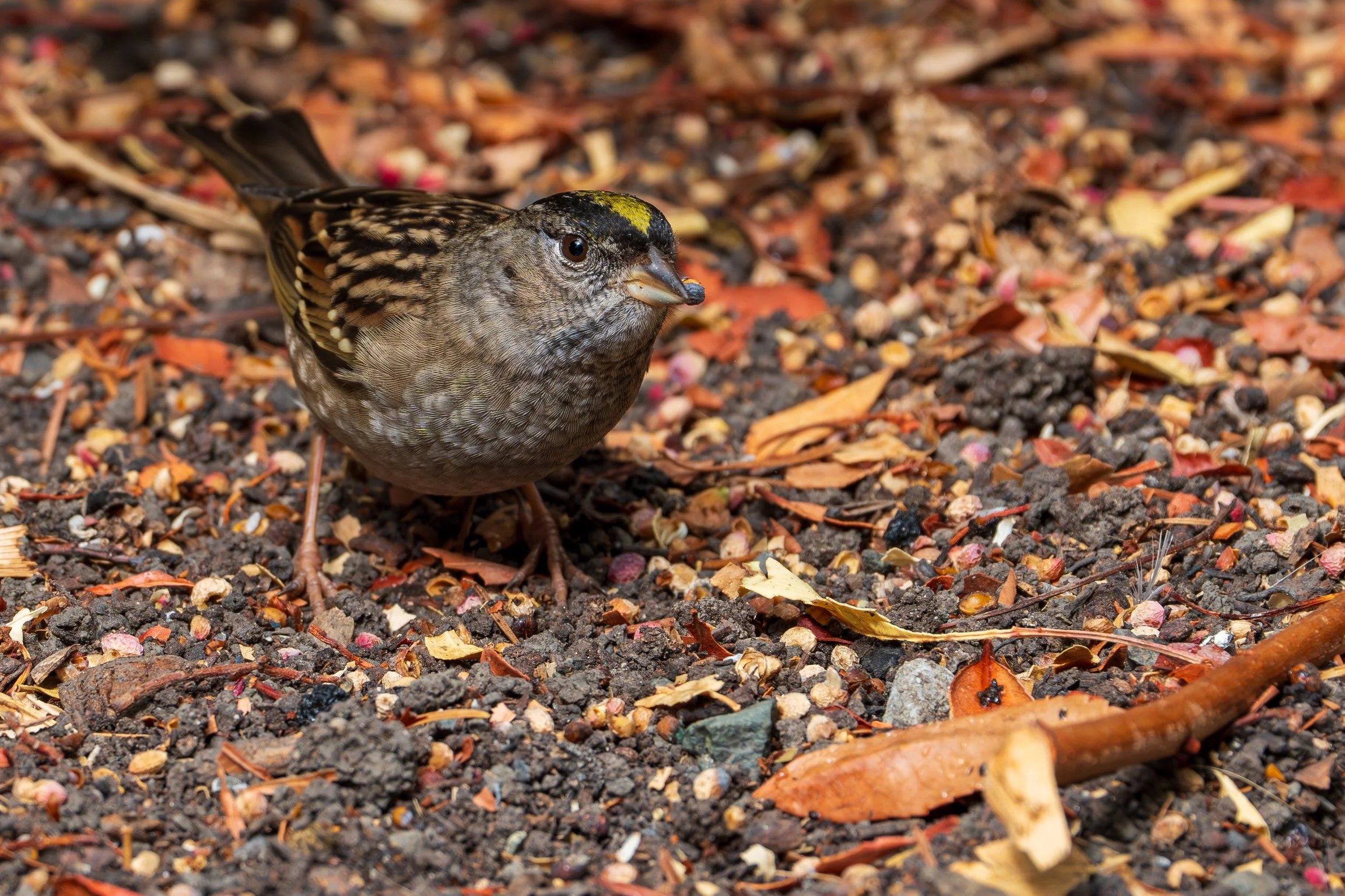BACKYARD BIRD OBSERVATIONS FROM OUR MEMBERS AND FRIENDS
It’s fall, and the birds that grace our neighborhoods during the cooler months have arrived!
Many of you reported our ubiquitous winter sparrows, the White-crowned Sparrow and the Golden-crowned Sparrow, in your yards starting in late September or early October. Our two most common winter warblers - the Yellow-rumped Warbler and the Townsend’s Warbler - are also here now. Yellow-rumped Warblers seem especially abundant now, with large numbers of them foraging for fruits and seeds in the foliage.
You also saw and heard other iconic winter species, like Northern Flickers, Ruby-crowned Kinglets, Hermit Thrushes, Cedar Waxwings, and American Goldfinches. These birds arrive here from elsewhere to spend the winter, or are simply more common in residential areas during this season. And two of you told us about a special phenomenon: a bird, perhaps the same individual, that returns to a favorite winter spot in your neighborhood, year after year - a Merlin in Santa Clara and a Red-breasted Sapsucker in San Jose.
As we head into the cooler rainy season, many plants are blooming and fruiting, and you noticed birds foraging in them for food. The Chinese pistache, with its bountiful clusters of red berries, is popular with a good number of bird species. Other plants that have attracted birds to your neighborhoods include privet, persimmon, olive, ivy, and sage.
A number of you commented on bird behavior, for example, American Crows gathering in large numbers; the antics of Wild Turkeys being reintroduced to the wild after rehabilitation; and dominance struggles between California Scrub-Jays and Steller’s Jays. You also noticed and worried about injured birds, like an Acorn Woodpecker and an American Robin. (You’ll find suggestions below for how to handle this last situation.)
Our year-round residents are getting ready for winter too, and you’ve spotted them foraging, hunting, resting, and socializing: these include Mourning Doves, Anna’s Hummingbirds, Cooper’s Hawks, Red-tailed Hawks, Black Phoebes, Bewick’s Wrens, Chestnut-backed Chickadees, Northern Mockingbirds, House Finches, and Dark-eyed Juncos. And at night, you’ve heard Great Horned Owls and Killdeer out in the darkness.
This month, the American Coot makes its All Around Town debut. This wetlands bird, a member of the rail family, was spotted at a Valley Water property in the middle of a busy area of San Jose. American Coots have black feathers, offset by a white bill, and are shaped somewhat like a chicken. Look for them swimming on the bay and in ponds and lakes around our county.
Here are your backyard and neighborhood bird observations from the second half of September and the month of October (and even a few from the first part of November):
A White-crowned Sparrow sips water at LC’s bird bath. Adult White-crowned Sparrows have white and black crown stripes; immature birds have gray and brown crown stripes.
LC Boros (San Jose) says: “All of our orioles have departed and in their place are flocks of Golden-crowned Sparrows and White-crowned Sparrows.”
A Northern Mockingbird visits the wrong end (from our perspective) of LC’s bird cam.
“We stream the north garden here at the ranch 24/7 now, and BirdWeather processes the audio and pushes that data up to the Cornell Lab of Ornithology. Some of the camera setups are also used as perches by the birds.”
[Editor’s Note: BirdWeather is an online platform that shows you the birds and other animals that audio stations around the world are sensing. It relies on BirdNET, a neural network developed by the Cornell Lab of Ornithology and the Chemnitz University of Technology, to identify the species whose sounds are picked up by the stations.]
A Wild Turkey infiltrates LC’s home!
LC continues: “Our resident Red-tailed Hawks are now parking daily on the old mast pole, much to the consternation of the two Wild Turkeys we released here at the ranch. Orphans raised by the Wildlife Center of Silicon Valley where I volunteer, the pair were originally slated to join the wild flock that is usually in residence here, but of course since the day I brought home the foundlings, the usual small herd of truly wild turkeys has failed to show. This has created a few unusual moments like when one of the youngsters snuck into the house via the front doors and then proceeded to fly through the house and into my office. It took a good twenty minutes to convince her to leave the roof of my sound booth and exit the house. Unlike the polite feral peafowl that have shown a similar curiosity about human dwellings, the turkey decided to leave me a few ‘presents.’”
A group of California Scrub-Jays takes over LC’s peanut feeder.
“In the unending battle for garden supremacy, it seems that our California Scrub-Jays have adopted a new tactic this year. Unlike past years when either the parents or recently-fledged young departed the immediate area, this fall we now have a full flock as the family has remained in residence in an effort to claim dominance over our resident pair of Steller’s Jays. This new behavior is a tad annoying for it means they empty out the peanut feeder within hours of my assistant refilling it as they hurry to cache as many nuts as possible. We’re hoping that switching to shelled peanuts in the coming weeks will alleviate this rather wasteful behavior.”
A Mourning Dove (left) is curious about a California Quail.
LC concludes: “Other than the usual comings and goings (including our Mourning Doves trying to befriend various other species) we have had a few unfortunate sightings such as an Acorn Woodpecker with a damaged beak that was making do with calories from seeds, and a dying mule deer that had to be dispatched by a county sheriff.”
A Milpitas contributor writes: “I’m glad to have captured some photos of the fall/winter birds that are coming to the neighborhood.”
A Hermit Thrush visits a Milpitas yard.
“On October 10, I heard some ‘chup chup’ calls and ran out with my camera just in time to capture some photos of a Hermit Thrush on the fence trying to eat the late-season goji berries. Then came photos of the female Northern Flicker in the front yard. The male flickers were very loud around the neighborhood but I haven’t been able to photograph them this fall.”
Cedar Waxwings flock in a tree. These birds visit our residential neighborhoods in large numbers during the winter, foraging fruits and berries from the trees.
“Also, we have flocks of up to fifty Cedar Waxwings flying around the neighborhood, which I haven’t seen yet at nearby local hotspots.”
A Western Flycatcher spotted at a neighborhood park in Milpitas. These birds are migratory, and leave our area in the fall for their winter homes further south.
The contributor continues: “As late as October 14, I saw a Pacific-slope Flycatcher (which is now called ‘Western Flycatcher’) at our neighborhood park, but it was not marked ‘unusual’ or ‘rare’ on eBird, so I guess they can stay in the area that late in the year.”
“The American Robins have come back in dozens too. And of course, the active Ruby-crowned Kinglets are at every park. I also saw a Say’s Phoebe at Sinnott Park after a few months’ absence.”
A Red-breasted Nuthatch with a seed in its bill
“Also, this seems to be an irruption year for Red-breasted Nuthatches, as it seems like they’re everywhere with pine or redwood trees.”
The tail of a Great Horned Owl, one of a pair that has been visiting a Milpitas neighborhood at night.
“Lately the Great Horned Owls from Ed R. Levin County Park have been coming to my neighborhood at night. I have heard them hooting in the middle of the night or near early morning. On October 28, right at sunset, a pair of Great Horned Owls perched on the tall redwoods and were dueting back and forth for 15 to 20 minutes before they flew away. I tried to take pictures in the coming darkness but later realized that the owl was facing us backwards. I got only some tail shots.”
A Red-breasted Sapsucker spotted at a Milpitas park. These birds migrate here to spend their winters with us. They are recognizable by their deeply-saturated red head, neck, and breast.
Our Milpitas contributor adds: “I also saw a stunning Red-breasted Sapsucker in early November at the neighborhood park and was able to get pictures after failed attempts for two or three years now to capture them on camera. They are one of my favorite winter birds.”
Eve Meier (San Jose) writes: “I think this time of year is my favorite for birding! There's lots to see. Yesterday I went to Valley Water (formerly called the Santa Clara Valley Water District) and watched an almost-adult American Coot trying to navigate down the face of the dam. It tried walking it but stumbled very ungracefully down, plopping into the water below. Very entertaining!”
She adds: “This is a fun time in my yard because my olive tree drops all of its olives. The birds love it! I've seen Yellow-rumped Warblers, House Finches, California Towhees, Hermit Thrushes, Western Bluebirds, and Dark-eyed Juncos all enjoying the olives or the insects that are attracted to the olives. It makes for great birdwatching right out my kitchen window!”
On September 26, Eve wrote: “Guess who’s back? My Red-breasted Sapsucker in a neighboring cedar tree. I don’t actually know that it’s the same bird, of course, but I like to think that it is. This is the fourth year in a row now.”
Eve has reported this sapsucker, or a sapsucker in the same tree, to All Around Town each winter since she first spotted it. In previous years, her first sightings were in October, November, or December, so this is the earliest that she’s seen the bird.
Young birder Camden Bac (Sunnyvale) shared some photos of the birds he spotted in his yard with us.
Camden’s mother Cheryl writes: “Camden's sister put out some bird seed and the Dark-eyed Juncos (photo above) like it.”
A House Finch visits an orange tree.
There are a lot of House Finches in Camden’s yard.
Cheryl says: “Camden was very excited that he got a picture of this White-breasted Nuthatch. Usually we don't see nuthatches in our yard.”
“Camden was concerned about this American Robin. It looked like it might be injured.” Camden observed the bird once but has not seen it since.
[Editor’s Note: It can be hard to know if and when to intervene to help a wild animal. Please refer to our web page about Injured Birds and Other Wildlife for resources (SCVAS cannot retrieve or accept animals ourselves). Please do not attempt to care for an injured bird yourself. Birds need specialized care to be successfully rehabilitated, and it is against the law to possess most wild birds without a permit.]
Steven Rice (Palo Alto) captured these images at his home in the first part of November:
An Anna’s Hummingbird visits Steven’s sage plant. Red feathers limited to the gorget (throat patch), and the extensive white tips of the outer tail feathers, make this bird identifiable as a female.
A Yellow-rumped Warbler forages for seeds near Steven’s home.
An attentive Bewick’s Wren, photographed by Steven. The bird’s thick white “eyebrow” can be clearly seen.
Emma Shelton (Menlo Park) says: “The American Crows are unbelievably numerous and noisy lately. Is there something going on in particular? Every evening it seems like hundreds circle around, making a lot of squawking, outdoing even the airplanes.”
[Editor’s Note: Something is indeed going on! In the fall and winter, you may notice increasingly large numbers of crows congregating together. This is because after the breeding season, during which the birds maintain family territories, crows tend to spend the night together in communal roosts. These roosts can have anywhere from several hundred birds to over two million!]
She continues: “Downy Woodpeckers and Nuttall’s Woodpeckers live in the big valley oaks near our house, and they will make a visit every few days to the feeder so I can see them.”
Emma spotted her first White-crowned Sparrow of the season in her yard on September 13. These sparrows have been continuously visiting her yard since September 28. She had her first Golden-crowned Sparrow of the season at the end of September. She writes: “Both Golden-crowned and White-crowned Sparrows hang out every year in the yard, gathering up what they can under the feeders and plants.”
Emma says: “The Mourning Doves saw what fun the Lesser Goldfinches were having in the spa and decided to try it for themselves. I think they might need a bigger pool.”
Here is Emma’s yard and neighborhood list for mid-September through October:
Canada Goose
Rock Pigeon
Mourning Dove
Anna’s Hummingbird
California Gull
Turkey Vulture
Cooper’s Hawk
Downy Woodpecker
Nuttall’s Woodpecker
California Scrub-Jay
American Crow
Chestnut-backed Chickadee
Oak Titmouse
Bushtit
White-breasted Nuthatch
Pygmy Nuthatch
Bewick’s Wren
House Finch
Lesser Goldfinch
Dark-eyed Junco
White-crowned Sparrow
Golden-crowned Sparrow
California Towhee
Spotted Towhee
Emma writes: “Out in Portola Valley, Acorn Woodpeckers have covered about every inch of a telephone pole with their granary!” Acorn Woodpeckers are social birds, and work together to store acorns in a “granary,” a tree or another structure that they use as a sort of acorn silo.
Unice Chang (San Jose) writes: “I noticed this fall was not as birdy as previous years. So far, our common guests in the backyard are Nuttall’s Woodpeckers, Yellow-rumped Warblers, Anna’s Hummingbirds, and Dark-eyed Juncos.”
An Anna’s Hummingbird inspects Unice’s plants.
“Anna’s Hummingbirds and Black Phoebes normally hang out on my patio. Even though my hummingbird feeder is very low (almost at my eye level), right next to the window in the door, it seems not to bother them at all.”
A Nuttall’s Woodpecker alerts Unice to his presence. Adult male Nuttall’s Woodpeckers have an extensive red patch on the back of the head.
“The most interesting thing is when woodpeckers and phoebes come, they normally make sounds to notify me of their arrival. Only woodpeckers and hummingbirds (on my patio) appreciate the feeders I have for them. Juncos like to find food on the ground and the rest of the birds just visit, hopping around the trees.”
“I am still waiting for the usual Cedar Waxwings to show up in my backyard. Their late appearance may be due to the weather change. Our persimmons are not fully ripe yet. We just had our first persimmon of the year this week, and I look forward to having waxwings and Yellow-rumped Warblers come to enjoy the feast soon.”
A Merlin perches in Airdrie’s neighborhood sycamore.
Airdrie Kincaid (Santa Clara) writes: “On October 27, a Merlin perched on a neighboring sycamore tree. I’ve photographed one there during the past three winters, but that date when the leaves are still green is the earliest we’ve spotted it.”
This is the third winter that Airdrie has reported a Merlin in this spot to All Around Town. You can see pictures of the Merlin that visited this same sycamore tree in February 2022, January 2022, and February 2021.
An American Crow (left) harasses the Merlin.
“After I photographed an American Crow trying unsuccessfully to chase it away, the Merlin stayed for a while before leaving. Since then I’ve only seen crows, American Robins, House Finches, and a Black Phoebe on that branch.”
“The persimmons on our 50+-year-old tree are starting to ripen and crows have tried to eat them. After the leaves turn and fall, we can usually see lots of birds including woodpeckers and sapsuckers.”
A House Finch enjoys privet berries in Airdrie’s neighborhood.
“A neighboring glossy privet (Ligustrum lucidum) has thousands of berries. Although it is an invasive species, it’s popular with birds. House Finches are eating the berries green, and American Robins and Cedar Waxwings eat them once they get ripe.”
Airdrie continues: “A Yellow-rumped Warbler has been singing loudly. The other birds we’ve spotted recently in our backyard include a flock of ten Mourning Doves on the ground under a feeder, White-crowned Sparrows, Chestnut-backed Chickadees, a pair of White-breasted Nuthatches, California Towhees, a Northern Mockingbird, an Anna’s Hummingbird, a Bewick’s Wren, and a California Scrub-Jay.”
Kristin Lynn (San Jose) writes: “Fall's off to a great start! I started hearing White-crowned Sparrows quite frequently in late September, especially in the morning. I also had my first Yellow-rumped Warbler visit of the fall in early October.”
A Eurasian Collared-Dove near Kristin’s home. The thin black line on the back of the neck, or “collar,” is visible.
“I was surprised to see a pair of Eurasian Collared-Doves in a tree across the way, because I haven't heard them in a while.”
“Black Phoebes (above) visited the balcony on two different occasions in October (this is pretty rare, and a sunny-day visit even rarer). Such a treat!”
Kristin adds: “I've been hearing Killdeer at night pretty frequently. I love hearing them. They were especially vocal one particular night in late September, when I recorded them.”
A Cooper’s Hawk visits Deanne’s fountain.
Deanne Tucker (Los Altos) had a Cooper’s Hawk visit her fountain in late October, but it was too quick to photograph, despite multiple visits. Finally, she writes, “it stayed long enough for me to run for my camera which happened to have a smaller lens on it from another event I was photographing. My regular long bird lens would probably not get the whole hawk in the frame from this close! Again, I had to shoot through the window, but it's a better shot than with a phone.”
Molly Graham (Mountain View) sent us some photos and stories of birds she’s seen in her yard and neighborhood recently:
A Townsend’s Warbler in Molly’s yard. Note the bird’s black eye line and cheek patch, and white barring in the wing.
Townsend’s Warblers have been visiting Molly’s yard. She writes: “The first time I was able to get photos I had actually been in my yard taking pictures of Black Phoebes when I heard their distinct call before a flash of yellow. I've seen them a few times since, including nervously hanging around before taking a drink at the bird bath.”
“The Red-breasted Nuthatches have been continuing in the neighborhood. I see the female more often than the male, who tends to get in and out of the feeders more quickly.”
Two Yellow-rumped Warblers have a stand-off in Molly’s yard. In addition to the lemony splash of color on their rump, these birds usually have yellow on their flanks, throat, and crown too.
“The Yellow-rumped Warblers have been numerous and often will be seen waiting for an opportunity to make a stop at the bird bath if they're not higher up in the trees.”
An American Goldfinch visits Molly’s yard. This bird’s winter plumage looks very different from its breeding plumage, which is bright yellow. In the winter, the birds have a muted brown body and a yellow head.
“There were a couple of days earlier in October when an American Goldfinch was flocking with the other finches who frequent my feeder. I noticed it would linger around the House Finches longer than the Lesser Goldfinches would.”
“A Bewick's Wren has been going into the open where I can see it a lot more. I'll see it eating on the ground with the doves or making trips to the thistle seed feeder that I relocated to a table recently.”
This Chestnut-backed Chickadee has a lot of white streaks in its plumage.
“Recently I noticed an unusual-looking Chestnut-backed Chickadee that started visiting the feeder. I had to get some shots to get a closer look at its interesting mix of white feathers and some streaking from the usually clean-cut cap and throat.”
A Golden-crowned Sparrow forages seeds and berries, photographed by Molly.
“I took a walk during some light showers and a mixed flock of sparrows (including Golden-crowned Sparrows) were singing and enjoying the berries scattered around in a nearby parking lot.”
A Bushtit takes a leaf bath, enjoying the water that accumulates on leaves when it rains.
Molly adds: “I was also lucky to see a trio of Bushtits splashing around and drinking off of leaves growing over a fence.”
Happy backyard birding, everyone!
What birds are you seeing and hearing in your yard and neighborhood?
Send your stories, lists, photos, sketches, videos, and audio clips to backyardbirds@scvas.org. We’ll feature them in our next edition of All Around Town.
Bird species reported to All Around Town from October 2020 onwards
Species in bold were reported for the first time in this edition.
Greater White-fronted Goose
Canada Goose
Mallard
Bufflehead
Hooded Merganser
California Quail
Wild Turkey
Indian Peafowl (feral)
Rock Pigeon
Band-tailed Pigeon
Eurasian Collared-Dove
Mourning Dove
Vaux’s Swift
White-throated Swift
Anna’s Hummingbird
Rufous Hummingbird
Allen’s Hummingbird
American Coot
Killdeer
Long-billed Curlew
California Gull
Double-crested Cormorant
Great Blue Heron
Great Egret
Snowy Egret
Black-crowned Night-Heron
Turkey Vulture
White-tailed Kite
Golden Eagle
Northern Harrier
Sharp-shinned Hawk
Cooper’s Hawk
Bald Eagle
Red-shouldered Hawk
Red-tailed Hawk
Ferruginous Hawk
Barn Owl
Western Screech-Owl
Great Horned Owl
Belted Kingfisher
Red-breasted Sapsucker
Acorn Woodpecker
Downy Woodpecker
Nuttall’s Woodpecker
Hairy Woodpecker
Pileated Woodpecker
Northern Flicker
American Kestrel
Merlin
Olive-sided Flycatcher
Western Wood-Pewee
Willow Flycatcher
Western Flycatcher (formerly called “Pacific-slope Flycatcher”)
Black Phoebe
Say’s Phoebe
Ash-throated Flycatcher
Western Kingbird
Hutton’s Vireo
Cassin’s Vireo
Warbling Vireo
Steller’s Jay
California Scrub-Jay
Yellow-billed Magpie
American Crow
Common Raven
Chestnut-backed Chickadee
Oak Titmouse
Northern Rough-winged Swallow
Tree Swallow
Violet-green Swallow
Barn Swallow
Cliff Swallow
Bushtit
Wrentit
Ruby-crowned Kinglet
Red-breasted Nuthatch
White-breasted Nuthatch
Pygmy Nuthatch
Brown Creeper
House Wren
Bewick’s Wren
European Starling
California Thrasher
Northern Mockingbird
Western Bluebird
Varied Thrush
Hermit Thrush
American Robin
Cedar Waxwing
Scaly-breasted Munia
House Sparrow
House Finch
Purple Finch
Pine Siskin
Lesser Goldfinch
Lawrence’s Goldfinch
American Goldfinch
Chipping Sparrow
Fox Sparrow
Dark-eyed Junco
White-crowned Sparrow
Golden-crowned Sparrow
White-throated Sparrow
Savannah Sparrow
Song Sparrow
Lincoln’s Sparrow
California Towhee
Spotted Towhee
Western Meadowlark
Hooded Oriole
Bullock’s Oriole
Red-winged Blackbird
Brown-headed Cowbird
Brewer’s Blackbird
Northern Waterthrush
Orange-crowned Warbler
Yellow Warbler
Yellow-rumped Warbler
Black-throated Gray Warbler
Townsend’s Warbler
Canada Warbler
Wilson’s Warbler
Western Tanager
Black-headed Grosbeak
Lazuli Bunting
Painted Bunting
Hybrid ducks, domestic ducks, unidentified gull species, and Rufous/Allen’s Hummingbirds have also been reported to All Around Town.
References
All About Birds website, www.allaboutbirds.org. Cornell Lab of Ornithology, Ithaca, NY, USA.
Birds of the World. Edited by S. M. Billerman, B. K. Keeney, P. G. Rodewald, and T. S. Schulenberg. Cornell Laboratory of Ornithology, Ithaca, NY, USA. https://birdsoftheworld.org/bow/home
eBird: An online database of bird distribution and abundance [web application]. eBird, Cornell Lab of Ornithology, Ithaca, NY, USA. http://www.ebird.org
All Around Town is compiled by SCVAS Member Julie Amato.
Banner Photo: Hermit Thrush photographed by a Milpitas contributor




